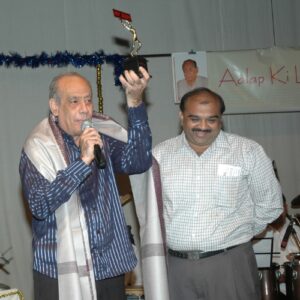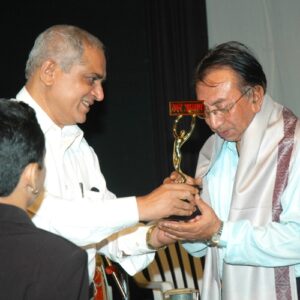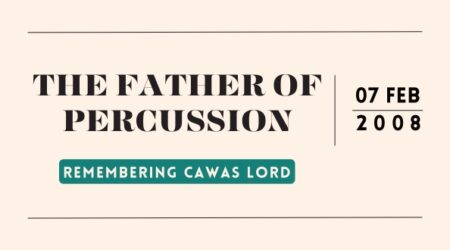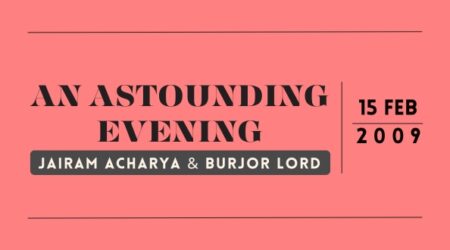2007: Percussions All The Way
Shankar Iyer | burmanfan@gmail.com
Mysore Association Hall, Matunga witnessed a special musical event on 21″ July, 2007- Percussions All The Way had Felicitation of Hindi films’ multi-instrumentalist Homi Mullan and leading Nepali films music director and Maadal player Ranjit Gazmer. The occasion also saw ace drummer Franco Vaz taking stage to enthral viewers. The episode embossed organizing group Swar Aalap’s dedicated commitment to the cause of promoting and supporting musicians. The musicians who played for innumerable film songs, imparting their own feeling and ardour to create the long-lasting appeal that music lovers have grown and lived with.
There has hardly been a phase in Hindi cinema when music and have not been the heart of films. Just as every great concept needs brilliant execution to succeed. The song compositions could not have imbibed the final essence and character had it not been for the dedicated passion of hundreds of musicians behind the scenes constituting a formidable part of the music composers’ teams.
First star of the evening Ranjit Gazmer:
 Setting the perfect mood and expectation, the curtains opened with the legendary title music of ‘Sholay’. Welcoming guests to the show, Kushal introduced the first star of the evening Ranjit Gazmer, fondly known as Kanchaji, a key member of RD Burman’s highly successful musical team. Born in 1941 in a family of gold merchants, Ranjit Gazmer learnt to play almost all percussion instruments. More interestingly, Ranjit Gazmer has the unique distinction of regularly playing and elevating the one and only Maadal, the sounds of which fetch the aroma of the mountainous landscapes of Darjeeling, his very birthplace. These sharp ringing notes have not only lent immortality to hundreds of songs, but have given a special sheen and shine to the music of the 1970s and 1980s. A song played on stage to portray the Maadal’s different colours – RD Burman’s Tere bina jiya jaaye Na (Ghar, 1977). Kanchaji fondly remembered how the composer encouraged the Maadal’s unique chord style playing that was jointly created with Homiji, Rijramji and Maruti Rao Keer.
Setting the perfect mood and expectation, the curtains opened with the legendary title music of ‘Sholay’. Welcoming guests to the show, Kushal introduced the first star of the evening Ranjit Gazmer, fondly known as Kanchaji, a key member of RD Burman’s highly successful musical team. Born in 1941 in a family of gold merchants, Ranjit Gazmer learnt to play almost all percussion instruments. More interestingly, Ranjit Gazmer has the unique distinction of regularly playing and elevating the one and only Maadal, the sounds of which fetch the aroma of the mountainous landscapes of Darjeeling, his very birthplace. These sharp ringing notes have not only lent immortality to hundreds of songs, but have given a special sheen and shine to the music of the 1970s and 1980s. A song played on stage to portray the Maadal’s different colours – RD Burman’s Tere bina jiya jaaye Na (Ghar, 1977). Kanchaji fondly remembered how the composer encouraged the Maadal’s unique chord style playing that was jointly created with Homiji, Rijramji and Maruti Rao Keer.
An important member of the trend-setter RD Burman:
It was now time to introduce the second star of the evening Homi Mullan. Born in 1940, Homiji has been a very important member of the trend-setting musical team of the Burmans, since 1970. Playing a variety of percussion instruments, Homi Mullan has worked with a large number of music directors that can be said to represent three generations!
Beginning with playing the Plano and the Accordion, Homi Mullan specialized further in the Duggi, the instrument he is primarily associated with. Two live RD Burman songs that let the Duggi sounds permeate through O mere dil ke chain (Mere Jeevan Saathi, 1972) and Aanewala pal (Golmaal, 1979). It was sheer joy to see Homiji play the Duggi with such zeal and enthusiasm!
Aadesh remembered his early days:
 At this juncture, Homiji made it a point to invite music director Aadesh Shrivastav from the audience on to stage. Aadesh remembered his early days as musician and how he grew up learning from veterans like Homiji, Kanchaji and Franco Vaz. It was great to see a composer gratefully acknowledge the role of yesteryear music stalwarts. Surely, the way to go for all upcoming musicians!!!
At this juncture, Homiji made it a point to invite music director Aadesh Shrivastav from the audience on to stage. Aadesh remembered his early days as musician and how he grew up learning from veterans like Homiji, Kanchaji and Franco Vaz. It was great to see a composer gratefully acknowledge the role of yesteryear music stalwarts. Surely, the way to go for all upcoming musicians!!!
Beautifully integrating songs of the Maadal and the Duggi, the musical extravaganza progressed with two gems from the S D Burman stable Maadal in Ab to hai tumse (Abhimaan, 1973) and Duggi in Roop tera mastana (Aradhana, 1969). More splendid renderings followed Anand- Milind’s Papa kehte hain (Qayamat Se Qayamat Tak, 1988) featuring Franco Vaz, (original player) on the drums, and Salilda’s Jaaneman jaaneman (Chhoti Si Baat, 1976) capturing the elan of Homi Mullan’s Duggi.
The icing on the cake was the introduction of the Triangle in Aao na gale lagao na (Mere Jeevan Saathi, 1972). A thick, rounded length of steel bent in to an equilateral triangle, the Triangle has a high, clear and penetrating note. The instrument’s use in Hindi films has been pioneered by the all-time music legend Cawas Lord.
The first session of the alluring evening concluded with the shawl, memento and trophy felicitations for Homi Mullan by Shri Rustom Kothari, a staunch Swar Aalap loyalist and supporter and Ranjit Gazmer by Shri Arun Puranik, another devoted Swar Aalap writer and supporter. Touchingly enough, Shri Rustom Kothari brought out the extra-ordinary zeal and passion of Swar Aalap founders Mr. and Mrs. S.J Ghate and son Dinesh Ghate. Their single-minded mission of setting-up a platform to honour cine-musicians for their priceless contributions had fructified in this day of rare celebration and rejoices.
 A galaxy of stars that had assembled:
A galaxy of stars that had assembled:
In addition to Homi Mullan, Ranjit Gazmer and Franco Vaz, a host of illustrious musicians were welcomed on stage to grace the occasion Noted music arranger Prakash Varma, renowned film violinist and music composer Uttam Singh, versatile percussion player Burjor Lord, prominent Santoor player Pt. Ulhas Bapat, multi-faceted musician and music arranger Kersi Lord, eminent Sitar player and son of famous composer Pandit Bhagatram (of Husnalal Bhagatram duo) Pt. Ashok Sharma, reputed Sarod player Pta. Zarine Daruwala and renowned Mandolin player Kishor Desai. It was truly a galaxy of stars that had assembled to offer their distinctive presence and convey their whole-hearted support to the great and noble cause undertaken by Swar Aalap!!!
The curtains reopened to the romantic Shiv-Hari duet Dekha ek khwab, (Silsila, 1981) with Homiji on the Maadal. Interestingly, from this point, the mega-event advanced to perhaps the most interesting session of all, Homi Mullan reliving the charisma of a host of other noteworthy percussion instruments played in original R D Burman numbers. Displaying incredible energy and unbridled passion, Homiji delighted viewers by expertly playing the various original instruments that set the stage afire. e.g. the clicking sound of the Castanets, so wonderfully heard in the title track of ‘Betaab’ (1983) and Yunhi gaate raho (Saagar, 1985). A bonus in the Betaab track the special clatter sound of the ‘Donkey jaw, another music apparatus used to create a required special effect.
 Fabulous rhythm and Homi Mullan:
Fabulous rhythm and Homi Mullan:
How can one also forget the fabulous rhythm that Homi Mullan created on his thighs, to the back-ground of Yunhi gaate raho (Saagar, 1985)? Some more of such spirited playing from Homiji had the audience sit up and take notice of this multifarious musician – the ‘Kalimba’, a mini Piano of sorts, in Jhuk gayi aankhen (Bhola Bhala, 1978), the ‘Afro-harp’, made out of umbrella strings, in Sun bhai baarati (Warrant, 1975). More peculiar beats followed the differently played Cobasche in Tujhme kya hai deewane (Bade Dil Wala, 1983), and collision of sandpaper in Hum dono do premi (Ajnabee, 1974) and Hoga tumse pyara kaun (Zamane Ko Dikhana Hai, 1981).
The second icing layer on the cake – the incredible Accordion pieces in the instrumental Countless Caper (Shalimar, 1978). Viewers were left marvelling at the gifted ingenuity of this master musician, getting convinced that performers like him happen once in a generation!!!
Signature Sound of RD Burman:
The focus shifted back to Ranjit Gazmer and his exceptional sounding Maadal. Narrating anecdotes about the making of various songs, overwhelmed the audience with more and more interesting trivia. For e.g. how the name ‘Kancha’ stuck with Ranjit Gazmer during the making of ‘Hare Rama Hare Krishna‘; the song Lekar hum deewana dil (Yaadon Ki Baarat, 1973) recorded again with the Maadal after RD Burman having earlier remarked “Is mein to mera signature nahin hai” and the superb track of Asha Bhosle and Udit Narayan’s duet in Kanchaji’s Nepali film “Bansuri” that also featured few of the guests present – Ulhas Bapat on the Santoor, Burjor Lord on the Vibraphone and Aadesh Shrivastav on the drums!!! Absolute treasured information that music connoisseurs will continue to cherish!!!!
A series of memorable Maadal and Duggi songs ensued Ek ladki ko dekha (1942 A Love Story, 1993), Roz roz aankhon tale (Jeeva, 1986), Raat akeli hai (Jewel Thief, 1967), Mehbooba Mehbooba (Sholay, 1975) and I love you (Hare Rama Hare Krishna, 1971), There was nothing to match the thrill the audience was experiencing…as they hummed and clapped, watching the original players replay their own work 30 years after they had first created it!!!
The Band section:
Vocalists for the evening comprised of singers, Rajesh Iyer, Kavita Rajvansh lyer, and Chintamani. The instruments section featured Satish Nivaskar on the Lead Guitar, Milind Dabholkar and Rajesh Pawar on the Keyboards, Vinay Gavankar on the Bongos, Bhimrao Mohite on the Congo and the Dholak, Dilip Rane on the Bass Guitar and Anupam Ghatak on the Tumba. The fabulous sound system that had the audience in raptures was courtesy Mr. Zainuddin.
It was an evening when two all-round musicians had not only delighted their old fans, but also added many more names to their list of admirers. What’s more, the terrific camaraderie seen between musicians only asserted the underlying strong bonding and respect existing among like-minded and equally talented artistes. While you continue to wonder at the Caliber and poise of such musicians, no praise would be enough to commend the monumental effort taken by Swar Aalap to get such leading lights together…Hats off to the group’s single-minded devotion and commitment!!!













Comment (1)
Nice one. Enjoyed the best article.
Good one ???? Regards.mukesh